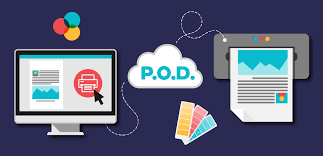
The Print-on-Demand (POD) business model is no longer an unfamiliar concept. It is the ideal “zero inventory risk” startup path for creators.
However, not everyone who joins succeeds. Fierce competition requires you to have a superior execution strategy.
This article will not only explain what the POD business model is, but will also delve into the 4 Decisive Factors that will help you break through and achieve a sales growth rate 5 times higher than your competitors.
I. 4 Decisive Factors for Success in the POD Business Model

1. The “Sniper” Strategy: In-Depth Niche Market Research
- Common Mistake: Selling overly generic designs or targeting a too-broad market (e.g., “I Love Dogs”).
- Successful Strategy: You must find a Micro-Niche. For example: Instead of “Dogs,” target “Husky Dog Owners in the Alaska region” or “Pitbull Lovers who work as Nurses.”
- Core Value: The narrower the niche, the better your designs can touch upon the emotions and Pain Points of customers, resulting in a higher Conversion Rate (CR).
- Tool Usage: Use tools like Google Trends, Reddit, and Etsy Bestsellers to find emerging trends rather than saturated ones.
2. Flexible Supply Chain (Fulfillment) Management
- The Harsh Truth: Print quality and Shipping Time directly affect your 5-star ratings.
- Partner Selection Criteria:
- Speed: Choose a supplier with fast Production Time and an optimized shipping network for your target market (US, Europe, Vietnam).
- Mockup Quality: Requires a library of high-quality, realistic mockups to reduce return rates.
- AOV (Average Order Value) Potential: Evaluate their ability to supply a variety of products to increase the average order value.
3. Creating Breakthrough Designs (Design Uniqueness)

- Design is the Soul: Designs must be exclusive and have a high degree of resistance to copying. Steer clear of overly simple designs that are easy to replicate.
- Trend-Catching Strategy: Quickly grasp prominent events, memes, or pop culture trends within 24-48 hours or holidays specific to each market, and launch related designs before competitors can react.
- The Power of Bundle: Create design sets (Bundle Designs) related to the same niche to implement Cross-selling and increase profit.
4. Data-Driven Marketing Strategy
- No Blind Advertising: Thoroughly analyze ROAS (Return On Ad Spend) and CPC (Cost Per Click) metrics for each design.
- Accurate Targeting: You need to deeply understand customer insights for each product to ensure accurate audience targeting.
- Leveraging Retargeting: Run remarketing ads to people who have viewed the product but have not yet purchased it.
- SEO for Long-tail Keywords: Optimize product descriptions for long-tail keywords (e.g., “gift t-shirt for retired physics teacher”).
II. The Secret to Increasing Sales 5 Times in the POD Business Model

1. Building Your Own Brand (Branding)
- Differentiation: POD is not just about selling shirts; it’s about selling a brand. Use a Custom Domain and design a consistent Logo and color palette for your store (Shopify or a private Store).
- Creating a USP (Unique Selling Proposition): For example: Your brand only sells 100% Organic Cotton T-shirts, or commits to donating $1 to an animal rescue charity for every order.
2. Conversion Rate Optimization (CRO)
- Beautiful Mockup Images: Use mockup photos featuring models wearing the product in real-life settings instead of just flat product images.
- Authentic Reviews: Encourage old customers to leave reviews (with photos) by offering a discount code for their next order.
- Creating Urgency: Use a Countdown Timer for limited-time sales.
3. Scaling Product Line
- Tiering Method: When a design succeeds on a T-shirt, quickly expand the print to other products like mugs, hats, posters, pillows, etc.
- Leveraging Upsell & Cross-sell:
- Upsell: Offer customers an upgrade to buy a Hoodie (higher price) instead of a T-shirt.
- Cross-sell: Suggest buying an extra mug with a similar design print.
4. Setting a High AOV (Average Order Value) Target
- Free Shipping: Set the free shipping threshold slightly higher than the price of the basic product (Example: Free shipping for orders over $50).
- Quantity Discount Strategy: Offer discounts for bulk purchases (Buy 2 get 15% off, Buy 3 get 25% off).
The POD business model is a strategic game, requiring the smooth combination of deep market research, operational optimization, and data-driven marketing.
Don’t just be a design seller; become a brand manager in the POD field.
